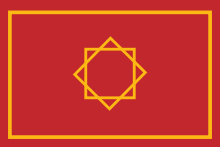- Mohammed ash-Sheikh
-
Mohammed ash-Sheikh
محمد الشيخSultan of Morocco 
Reign 1544 - 1557 Offspring Abdallah al-Ghalib (Sultan 1557-1574)
Abdelmoumen
Abd al-Malik (Sultan 1576-1578)
Ahmad al-Mansur (Sultan 1578-1603)Religious beliefs Islam  Mohammed ash-Sheikh initially had his capital in the southern Moroccan city of Taroudant, the walls of which he built. The capital was then moved to Marrakesh after its conquest in 1524.
Mohammed ash-Sheikh initially had his capital in the southern Moroccan city of Taroudant, the walls of which he built. The capital was then moved to Marrakesh after its conquest in 1524.
Mawlay Mohammed ash-Sheikh ash Sharif al-Hassani al-Drawi at-Tagmadert (died 1557) was the first sultan of the Saadi dynasty ruling over Morocco (1544–1557). "Al-Drawi at-Tagmadert" means: the man from the Draa river valley, from Tagmadert. He was particularly successful in expelling the Portuguese from most of their bases in Morocco. He also eliminated the Wattasids and resisted the Ottomans, thereby establishing a complete rule over Morocco.
Contents
War against the Portuguese
After the death of his father Abu Abdallah al-Qaim in 1517, Mohammed ash-Sheikh (together with his brother Ahmad al-Araj) took command of the war of the Saadi against the Portuguese. Their first success was against the Kingdom of Fez with the conquest of Marrakesh in 1524.[1]
Ahmad al-Aray became Sultan of Marrakesh, retaining contacts with the Wattasid Sultan of Fez, while Mohammed ash-Sheikh remained as ruler of Taroudant.[2]
In 1527, the Treaty of Tadla was passed between the Saadians and the Wattasids, following the Wattasid defeat in the battle of Wadi al-Abid. Both dynasties agreed to their dominion on respective territories, separated by Tadla.[1]
After 1536, and the rise in power of Araj, the brothers came into conflict with each other.[1] Ahmad al-Araj had in effect allied himself with the Wattasids under regent Ali Abu Hassun (1524–1554). Mohammed ash-Sheikh could maintain his position in Southern Morocco and conquered Agadir in 1541 and other coastal towns, ousting the Portuguese. After the loss of Agadir, the Portuguese immediately evacuated Azamor (1513–1541) and Safi (1488–1541).
Eventually, brother Ahmad al-Araj fled to Tafilalet.[2]
War against the Wattasids and Ottomans
After reorganising his army after Ottoman example he succeeded in conquering Fez in 1549, causing the downfall of the Wattasids. In the conquest of Fez he again used European artillery, which he had also used in the Fall of Agadir in 1541.[3] He then provided an army to his son, who was able to conquer Tlemcen in 1549, and throw out the Zayyanid ruler of the city.[4]
After the fall of Fez, Ksar-el-Kebir and Asila were also evacuated in 1550 by the Portuguese.[1] Finally, only Ceuta (1415–1668), Tangier (1471–1661) and Mazagan (1502–1769) remained in Portuguese hands.[5]
With help of the Ottomans, the Wattasids under Ali Abu Hassun were able to conquer Fez once more in early 1554, but that conquest was short-lived, and Mohammed ash-Sheik was able to vanquish the last Wattasids at the Battle of Tadla, and recapture the city of Fez in September 1554.[6] During the Ottoman Siege of Oran (1556), Mohammed ash-Sheikh, who was allied with the Spanish, managed to capture Tlemcen from the Ottomans.[6] With the final victory of the Saadi and the death of Ali Abu Hassun in 1554, the war was decided.
Death
Mohammed ash-Sheikh was assassinated by the Ottomans in 1557 by order of Hasan Pasha, son of Barbarossa, as he was preparing for an alliance with Spain against the Ottomans. Some Ottoman soldiers had falsely entered into his service, claiming to be deserters, and later assassinated him. He was buried in the Saadian Tombs of Marrakech. He was succeeded by his son Abdallah al-Ghalib.
See also
Notes
- ^ a b c d A history of the Maghrib in the Islamic period by Jamil M. Abun-Nasr p.211
- ^ a b The last great Muslim empires: history of the Muslim world Frank Ronald Charles Bagley, Hans Joachim Kissling p.102ff
- ^ The Cambridge history of Africa by J.D. Fage, John Desmond Clark, Roland Oliver, Richard Gray, John E. Flint, Neville Sanderson, Andrew Roberts, Michael Crowder p.405
- ^ The last great Muslim empires: history of the Muslim world by Frank Ronald Charles Bagley, Hans Joachim Kissling p.103
- ^ City walls: the urban enceinte in global perspective James D. Tracy p.352
- ^ a b A history of the Maghrib in the Islamic period by Jamil M. Abun-Nasr p.157
Preceded by
Ahmad al-ArajSaadi Dynasty
1544–1557Succeeded by
Abdallah al-GhalibCategories:- 1557 deaths
- Saadian dynasty
- People from Marrakech
- 16th-century Moroccan people
Wikimedia Foundation. 2010.
